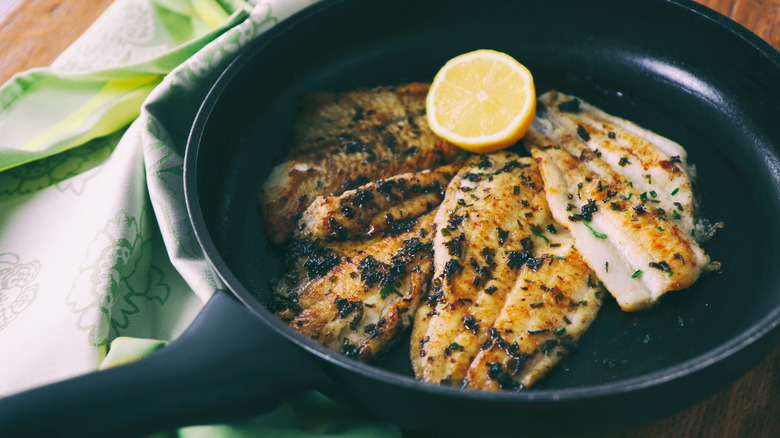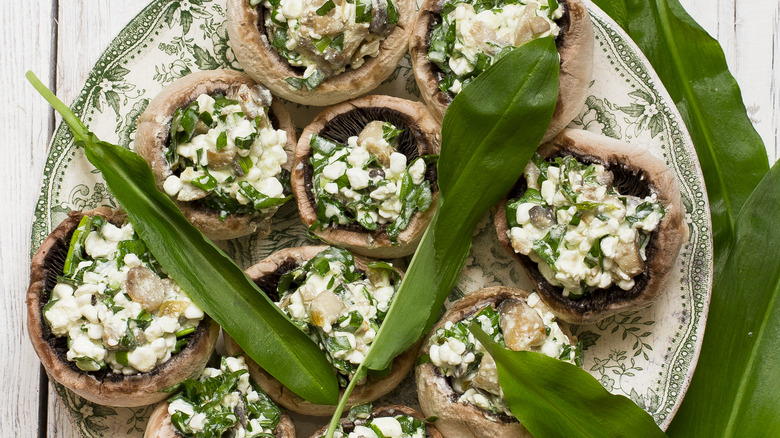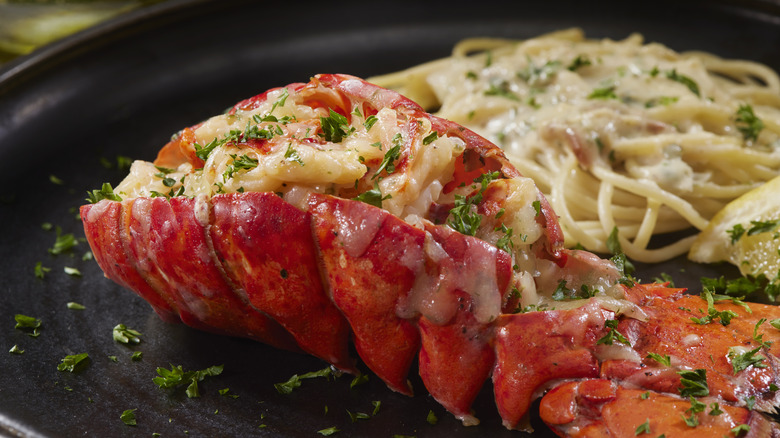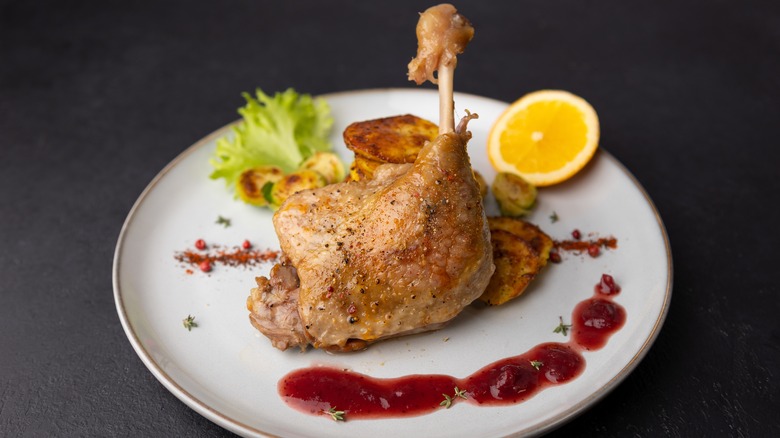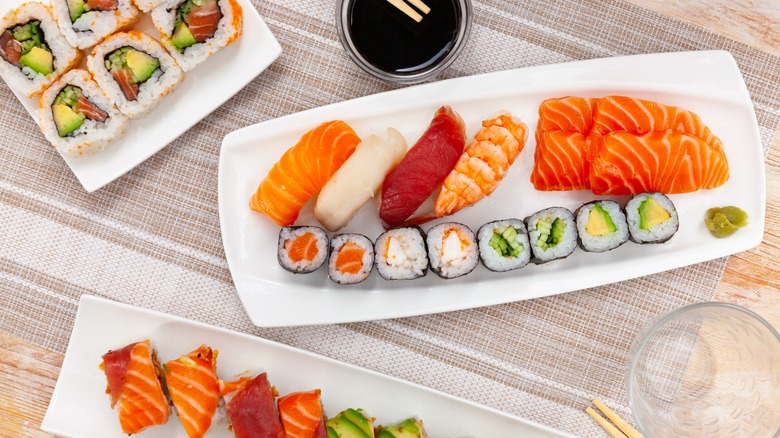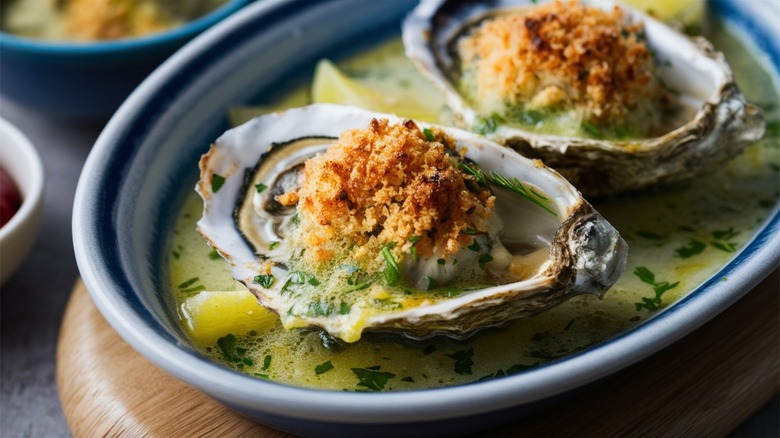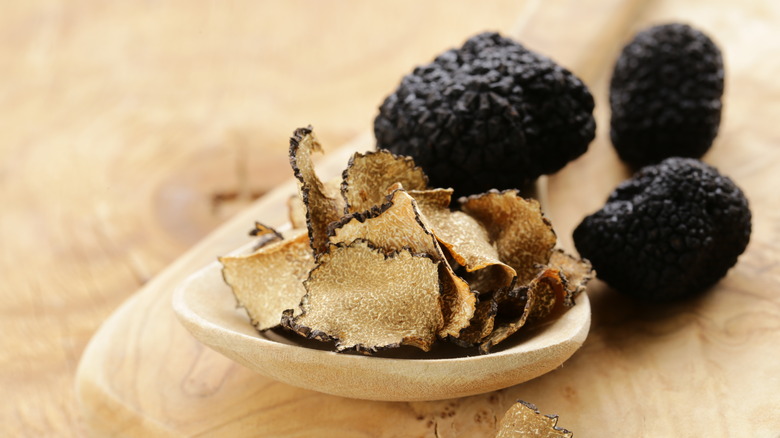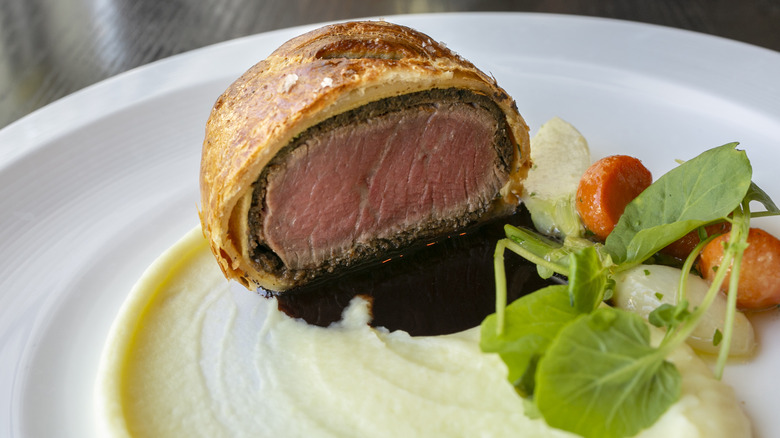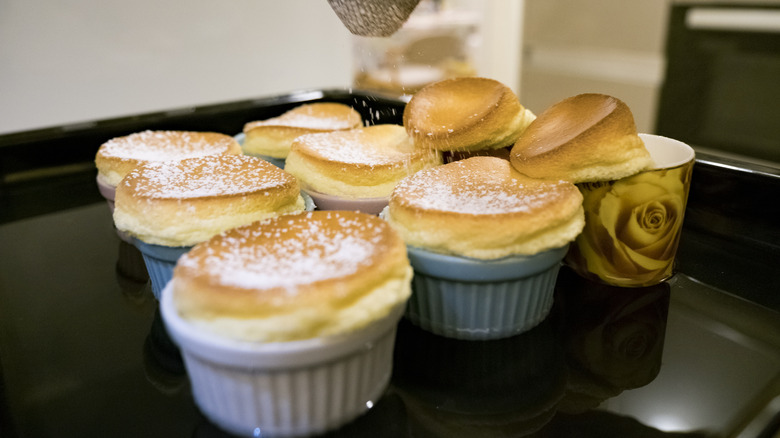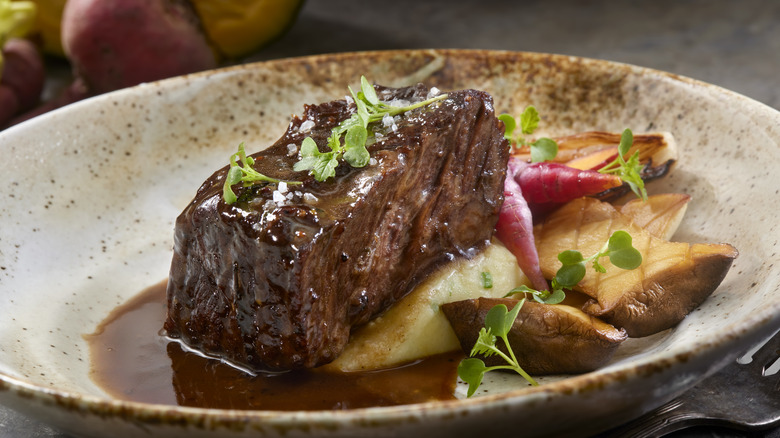13 Foods Restaurants Don't Really Want You To Order
When choosing a place to eat, it's often because the menu is appealing to you. As you place your order, you might assume that everything listed on it is fair game. However, there are certain foods restaurants just don't really want you to order. If you ask your waiter for recommendations, they are definitely going to steer you away from a few dishes to save themselves, the owner, and the kitchen staff the hassle.
Whether it's ordering tacos at an Italian restaurant, asking for a dozen modifications that make a dish unrecognizable, or insisting a steak should be burned because "the customer is always right," those working in hospitality have their fair share of horror stories to share. In this DailyMeal exclusive, we asked chefs, caterers, and restaurant entrepreneurs about the foods they wish customers would never ask for. Sometimes the dish is hard to make in a hurry, in other cases serving it is losing the restaurant money. Yet in every instance, no waiter wants to walk back to the kitchen and tell the chef about these customer requests.
1. Over-cooked fish
Certain fish can be hard to get right if you make too many modification requests. When it comes to delicate options, like a flounder, restaurants wish you could just leave your order alone. "When guests heavily modify a dish, it can throw off the balance of flavors and textures that we've carefully crafted," Nic Vanderbeeken, Executive Chef at Aperitif, told DailyMeal in an exclusive interview. "For example, ordering a delicate fish dish but asking for it to be well-done not only alters the intended experience, but also can result in a dry, unappetizing dish."
When you order fish this way, the waitstaff is worried you might not realize the mistake is yours. If you don't like the food, you might not leave as nice of a tip, especially if they explain why this happened. The chef is worried that they'll have to redo a dish that they wish they could have just prepared the right way, the first time. Instead, they wish you could save everyone the hassle and allow the chef to cook the fish as they see fit.
2. Stuffed mushrooms
If you see this dish on the menu, think twice before ordering it. "Stuffed mushrooms might sound simple, but they actually do require a lot of precision," Adonis Ouano Icalina, author, chef, and culinary entrepreneur at CarnivoreStyle told DailyMeal. The procedure for creating the food is complicated and time-consuming, making it hard to complete in the busy environment of a dinner rush. "Each mushroom cap has to be carefully hollowed out, and then filled with a mixture of ingredients that usually includes cheeses, breadcrumbs, and herbs," Ouano Icalina continued. "Preparing them in bulk can be super tricky because uniform cooking is crucial."
He has plenty of nightmare stories about what can go wrong when customers demand the dish, recalling a work event when his team was forced to prepare several hundred mushrooms. "Despite our best efforts, some came back with complaints because they were unevenly cooked—some were underdone and others overdone," he said. "This caused a lot of stress for the kitchen staff as we scrambled to fix the problem on the spot."
3. Lobster Thermidor
Lobster Thermidor is "very time-consuming, with intricate steps to execute flawlessly," Kevin Ashton, seasoned chef and current culinary advisor at Restaurantji, told DailyMeal exclusively, adding, "There is also a high risk for the dish to return to the kitchen over slight issues with sauce or texture." In his more than 40 years in the kitchen, Ashton has his fair share of stories about Lobster Thermidor. "One evening, a customer ordered this dish for a large group of ten. It was intricate and laborious to prepare, and we ran out of ingredients mid-prep. We had to substitute a different lobster variety, and while we made it work, it was a stressful ordeal."
This dish makes kitchen staff work harder and faster to get it ready on time; however, there are more reasons why waiters dread hearing you order it. "The key to this dish is using the freshest lobster available, but sourcing consistently fresh lobster can literally be a challenge, especially depending on the season," warned chef Adonis Ouano Icalina. Lobster is the rarest in the first few months of the year, so if you are determined to order this dish, restaurants wish you would wait until May, at least!
4. Duck Confit
Viewed as a delicacy by some, Duck Confit is a fan favorite in many restaurants. However, the staff often wishes guests wouldn't order it at all. "Duck confit is a dish that requires a slow, precise cooking process to achieve the perfect texture and flavor," explained Adonis Ouano Icalina. "The duck legs are cooked in their own fat, which must be done at a low temperature for an extended period. Any mistake in this process can lead to a dish that is too greasy or lacking in the desired crispness." Because it takes longer to prepare, waitstaff can be subject to complaints from restless customers who are wondering where their food is.
This restlessness, Ouano Icalina explained, is why he doesn't like preparing it in a restaurant setting. "The time and attention required for this dish make it difficult to execute consistently during busy services, and any deviation in preparation can result in a less-than-ideal dining experience." That is, if you are hungry and rush the dish's preparation, it's going to come out tasting bad. If it tastes bad, you send it back. This causes stress to the waitstaff, the kitchen staff, and you, too — since you are even more hungry than at the start of the ordeal.
5. Housemade pasta
When eating at an Italian restaurant, you might expect to enjoy all types of fresh, housemade pasta like authentic ravioli. However, ordering the same dish at a non-specialty restaurant might send the kitchen into a tizzy. "Handmade ravioli is extremely labor-intensive, especially during busy service," said Kevin Ashton. "When customers order multiple servings, it slows the kitchen down significantly." Ashton then recalled one particularly difficult evening when the dish was over-ordered. "There was one busy night when a couple ordered homemade ravioli with custom fillings for each person," he said. "The amount of time and attention this required in the middle of service nearly threw off our entire kitchen's pace."
What does make a difference, however, is the amount of pasta you order. As Ashton mentioned, one order of handmade ravioli might not shut down the kitchen, but four or five from the same table definitely would if the staff hadn't done enough prep. For this reason, your waiter is crossing their fingers that you won't ask for it. The type of pasta you request doesn't change the impact of the order, either — they are all just as hard! "Handmade gnocchi also requires patience and skill to perfect the texture," Ashton continued. "If rushed, it turns out gummy, which is something diners often return."
6. Sushi in non-sushi restaurants
You've just sat down at a steakhouse with your friends, but you've been craving sushi all day. If you see it on the menu, you might think it's a miracle and place your order, but chef Kevin Ashton wishes you would reconsider. "Even with trained chefs, freshness and quality suffer if the right kitchen equipment isn't in place," he said, warning against ordering sushi just anywhere. "I once worked in a kitchen where sushi was added to the menu as an afterthought. We didn't have the proper setup, often leading to complaints about the rice texture or fish not being as fresh as expected."
The end result is as you might expect: Many customers order sushi expecting the same quality as a specialty restaurant, but send the dishes back to the kitchen with complaints. This is because chefs who specialize in sushi have years of specific training. They also use special equipment to get the best results. Even with similar but cheaper tools, other restaurant types just aren't going to deliver the same quality sushi. The staff knows this, but when the owners put it on the menu, they have to make the dish when ordered. They just wish customers wouldn't ask for it.
7. Well-done steak
Cooking a perfect steak on the stove can be tricky. Yet for most chefs, the meat is a quick, easy dish to prepare — especially when the customer orders it correctly. While you can ask for a steak anywhere from blue to well done, restaurants tend to prefer you stay away from the overcooked end. "I've found that this request can be disheartening for chefs because it often means taking a high-quality cut of meat and cooking it to the point where it loses its tenderness and juiciness," said Nic Vanderbeeken. "It's a request that clashes with the respect we have for the ingredients."
Saying that it's painful for a chef to overcook a perfectly good piece of meat isn't an exaggeration. Kevin Ashton had the same answer. "Cooking a steak to this point compromises the quality of the meat, often leaving it dry and tough," he said. "Customers sometimes return it, asking for it to be 'less tough,' which contradicts the request for well-done." The most important thing to remember is that you can always ask for a piece of steak to be cooked more, but you can't uncook it, so to speak. Before ordering, take a look at this steak doneness temperature guide to familiarize yourself with the different levels. You might even have meant medium all along!
8. Oysters
If you are nowhere near an ocean, think twice about ordering Oysters Rockefeller. The restaurant staff is begging you! "The dish involves fresh oysters and requires meticulous preparation," warned Kevin Ashton. "One bad oyster can taint the dish and result in complaints." The number of times customers have sent the dish back complaining about something feeling "off" puts staff off wanting to serve Oysters Rockefeller to anybody. In fact, it's not just Oysters Rockefeller, but dishes involving these mollusks in general. "Serving raw oysters requires impeccable freshness and careful handling," Adonis Ouano Icalina explained. "They're highly sensitive to temperature and timing."
Oysters tend to be an expensive and exclusive dish. Because of this, many diners expect perfection. Even when following the best food safety practices, it's possible for a bad oyster to spoil your entire dish at a restaurant. This is because sometimes oysters that are off don't smell bad just yet, and only look slightly dry. A busy chef might not notice the smaller signs in the chaos of the dinner rush. "There was a time when we had an issue with the freshness of our oysters, which led to complaints about their taste and texture," Ouano Icalina shared. "The customer noted that the taste felt off and there was a hint that the oyster was spoiled." For all this drama, sometimes it's best to just not order oysters.
9. Fresh truffle dishes
Sometimes preparing a dish is easy enough, even during a hectic lunch rush. However, the reason restaurants don't really want you to order a food is because of how much effort it is to get it onto your plate — before the cooking even begins. "Truffles are rare and expensive, and sourcing them is challenging," Kevin Ashton lamented. Without knowing how many guests are going to order truffles, it can be hard to forecast exactly how much of the food to order. Miscalculations between supply and demand can lead to big financial losses for the restaurant.
In some cases, staff would prefer to just not serve the dish at all, as even with all the effort to have it in stock, people still just don't like truffles. "Often, customers are disappointed by the subtlety of the flavor relative to the high price tag," Ashton continued. After finding a supplier, negotiating prices, and taking a risk on orders and quantities, it's frustrating for chefs to see the dish come back with complaints or disappointments. Because of all this, sometimes restaurants wish no one would order truffles, so they could quietly remove the dish from the menu and save everyone the trouble.
10. Beef Wellington
Many diners enjoy a classic Beef Wellington and might be happy to see it on a menu. However, it can be a real pain. "Beef Wellington is a showstopper, but it comes with so many challenges," Adonis Ouano Icalina said. Anyone who has tried to make the dish at home can likely relate. Ensuring you don't overcook the beef when baking the puff pastry can be tricky. It takes good timing and plenty of practice to get right.
Unfortunately, even in professional environments, it's easy for there to be missteps when things are rushed. "I had an experience where the beef wasn't allowed to rest properly before being wrapped, which resulted in an uneven texture," Ouano Icalina shared. "The dish was meant to be the highlight of a special event, so fixing the issue quickly while maintaining quality was a real test for the team." Due to the possibility of missteps, and the high amount of stress Beef Wellington can cause, Ouano Icalina thinks it would be better for staff if guests didn't order this dish at all.
11. Duck à l'Orange
This dish is known for its sweet and tangy orange sauce. Traditionally, the duck meat is tender and delicious, while the sauce-coated skin has a signature crunch. However, some restaurants don't really want you to order Duck à l'Orange because they're pretty sure you won't like it much. "[It's a] classic, but with modern preferences shifting, the sweetness often clashes with customers' expectations," said Kevin Ashton. "Additionally, getting the duck perfectly crispy while maintaining a tender interior is tricky under pressure."
Ashton asserted that if the chef is going to painstakingly prepare Duck à l'Orange during a diner rush, they would like it to be appreciated by the guest. Unfortunately, he thinks more and more diners are sending the dish back for being far too sweet — misunderstanding the fact that this is a savory dish, with a twist. It's supposed to be that sweet! Because of this, most customers are better off not ordering this option at all, saving the restaurant the hassle.
12. Soufflé
Preparing a good soufflé can be quite stressful for chefs, leaving some of them wishing you never ordered the dessert. "This one is delicate and time-sensitive," said Kevin Ashton. If you've tried your own hand at soufflé, you'll know this truth all too well. These are temperamental little pastries that require a lot of attention. Now imagine trying to prepare one in a hectic kitchen with people moving every which way and plenty of loud noises. It's not the best environment for such a delicate dessert.
"Even a slight delay in service can cause it to deflate, resulting in customer disappointment," Ashton continued. Meaning that if a waiter doesn't collect the dessert immediately upon completion, it might be unservable by the time it arrives at the customer's table. They will then send it back and the process repeats. This anxiety-inducing cycle is why Ashton and others at restaurants are keeping their fingers crossed you'll just order the ice cream instead.
13. Braised short ribs
This is a delicious dish and a favorite of many. However, when prepared in an industrial kitchen alongside so many other foods, braised short ribs can easily fall short. Because of this, restaurants don't really want you to order them. "[They are] known for their rich flavor and tender texture, but achieving this result requires slow cooking and careful monitoring," shared Adonis Ouano Icalina. This is something busy chefs can't always do.
It can take ages to get the ribs to the right temperature, but you look away for just a moment and suddenly they are overcooked and dry — leading to unhappy customers. "It's challenging to predict the exact cooking time, especially when managing multiple orders at once," Ouano Icalina continued. "If the ribs aren't cooked to the perfect level of tenderness, they can end up tough or dry." This isn't something he wants to serve to guests, but it can happen sometimes in a busy kitchen. Because of this, he prefers guests order options which he can prepare a touch faster.

